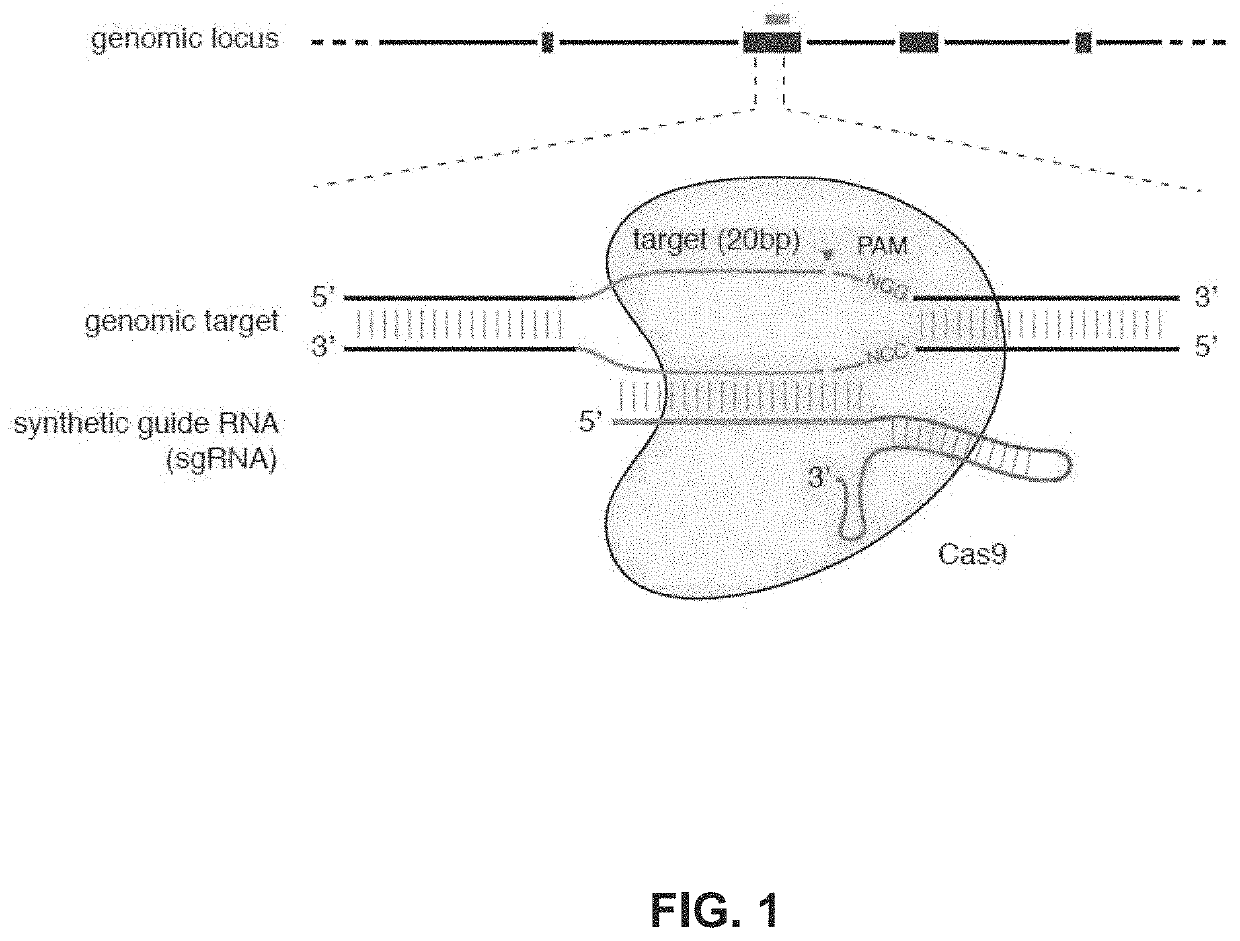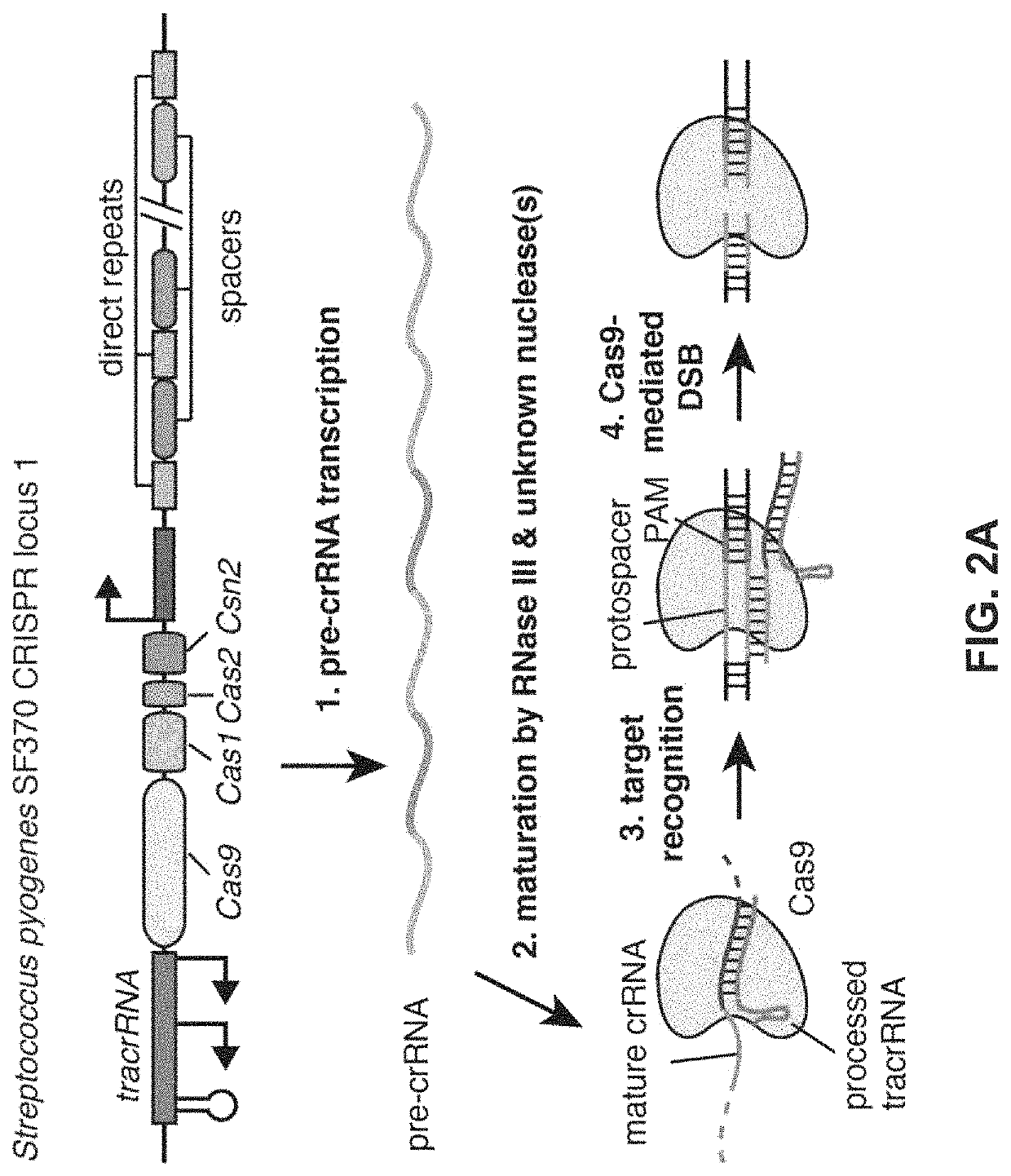Functional genomics using CRISPR-Cas systems, compositions, methods, screens and applications thereof
a technology of functional genomics and crisprcas, applied in the direction of biochemistry apparatus and processes, hydrolases, stable introduction of dna, etc., can solve the problems of limiting spatial control, using shrnas for functional genomic screens that are not advantageous, etc., to accelerate the ability to catalog and map, and simplify the methodology
- Summary
- Abstract
- Description
- Claims
- Application Information
AI Technical Summary
Benefits of technology
Problems solved by technology
Method used
Image
Examples
example 1
CRISPR Complex Activity in the Nucleus of a Eukaryotic Cell
[0284]An example type II CRISPR system is the type II CRISPR locus from Streptococcus pyogenes SF370, which contains a cluster of four genes Cas9, Cas1, Cas2, and Csn1, as well as two non-coding RNA elements, tracrRNA and a characteristic array of repetitive sequences (direct repeats) interspaced by short stretches of non-repetitive sequences (spacers, about 30 bp each). In this system, targeted DNA double-strand break (DSB) is generated in four sequential steps (FIG. 2A). First, two non-coding RNAs, the pre-crRNA array and tracrRNA, are transcribed from the CRISPR locus. Second, tracrRNA hybridizes to the direct repeats of pre-crRNA, which is then processed into mature crRNAs containing individual spacer sequences. Third, the mature crRNA:tracrRNA complex directs Cas9 to the DNA target consisting of the protospacer and the corresponding PAM via heteroduplex formation between the spacer region of the crRNA and the protospace...
example 2
CRISPR System Modifications and Alternatives
[0314]The ability to use RNA to program sequence-specific DNA cleavage defines a new class of genome engineering tools for a variety of research and industrial applications. Several aspects of the CRISPR system can be further improved to increase the efficiency and versatility of CRISPR targeting. Optimal Cas9 activity may depend on the availability of free Mg2+ at levels higher than that present in the mammalian nucleus (see e.g. Jinek et al., 2012, Science, 337:816), and the preference for an NGG motif immediately downstream of the protospacer restricts the ability to target on average every 12-bp in the human genome (FIG. 9, evaluating both plus and minus strands of human chromosomal sequences). Some of these constraints can be overcome by exploring the diversity of CRISPR loci across the microbial metagenome (see e.g. Makarova et al., 2011, Nat Rev Microbiol, 9:467). Other CRISPR loci may be transplanted into the mammalian cellular mil...
example 3
Sample Target Sequence Selection Algorithm
[0315]A software program is designed to identify candidate CRISPR target sequences on both strands of an input DNA sequence based on desired guide sequence length and a CRISPR motif sequence (PAM) for a specified CRISPR enzyme. For example, target sites for Cas9 from S. pyogenes, with PAM sequences NGG, may be identified by searching for 5′-Nx-NGG-3′ both on the input sequence and on the reverse-complement of the input. Likewise, target sites for Cas9 of S. thermophilus CRISPR1, with PAM sequence NNAGAAW, may be identified by searching for 5′-Nx-NNAGAAW-3′ (SEQ ID NO: 13) both on the input sequence and on the reverse-complement of the input. Likewise, target sites for Cas9 of S. thermophilus CRISPR3, with PAM sequence NGGNG, may be identified by searching for 5′-Nx-NGGNG-3′ both on the input sequence and on the reverse-complement of the input. The value “x” in Nx may be fixed by the program or specified by the user, such as 20.
[0316]Since mu...
PUM
| Property | Measurement | Unit |
|---|---|---|
| Composition | aaaaa | aaaaa |
Abstract
Description
Claims
Application Information
 Login to View More
Login to View More - R&D
- Intellectual Property
- Life Sciences
- Materials
- Tech Scout
- Unparalleled Data Quality
- Higher Quality Content
- 60% Fewer Hallucinations
Browse by: Latest US Patents, China's latest patents, Technical Efficacy Thesaurus, Application Domain, Technology Topic, Popular Technical Reports.
© 2025 PatSnap. All rights reserved.Legal|Privacy policy|Modern Slavery Act Transparency Statement|Sitemap|About US| Contact US: help@patsnap.com



